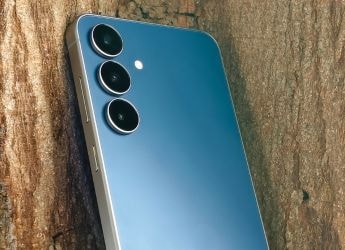- Home
- Mobiles
- Mobiles News
- OnePlus 10 Pro vs OnePlus 9 Pro vs OnePlus 9R: What's the Difference?
OnePlus 10 Pro vs OnePlus 9 Pro vs OnePlus 9R: What's the Difference?
OnePlus 10 Pro has been launched in China, while OnePlus 9 Pro and OnePlus 9R are available to purchase in India.

Photo Credit: OnePlus
OnePlus 10 Pro sports Hasselblad cameras
OnePlus 10 Pro was launched on January 11 by the Chinese company in its home market. The latest handset from OnePlus is an upgrade to last year's flagship, OnePlus 9 Pro. OnePlus 9R is the most affordable OnePlus 9 series smartphone which was launched alongside the vanilla OnePlus 9 last year. All three phones come with Hasselblad cameras with at least one (though different make) 48-megapixel sensor. OnePlus 10 Pro is expected to make its debut in India, however, there is no information on its launch in the country yet.
All the three OnePlus phones have several differences in hardware. OnePlus 10 Pro is the newest of all and has advanced features as compared to OnePlus 9 Pro, and OnePlus 9R. In this article, we will compare the specifications of OnePlus 10 Pro, OnePlus 9 Pro, and OnePlus 9R.
OnePlus 10 Pro vs OnePlus 9 Pro vs OnePlus 9R storage variants
OnePlus 10 Pro comes in three RAM and storage configurations — 8GB + 128GB, 8GB + 256GB, and 12GB + 256GB in Emerald Forest and Volcanic Black colours.
On the other hand, both OnePlus 9 Pro (Review) and OnePlus 9R (Review) are offered in 8GB + 128GB and 12GB + 256GB storage models. While OnePlus 9 Pro can be purchased in Morning Mist, Pine Green, and Stellar Black shades, OnePlus 9R debuted in Carbon Black and Lake Blue colour options.
OnePlus 10 Pro vs OnePlus 9 Pro vs OnePlus 9R: Specifications
OnePlus 10 Pro, OnePlus 9 Pro, and OnePlus 9R have dual-SIM (Nano) support and run on OxygenOS, based on Android. While OnePlus 10 Pro gets ColorOS 12.1, based on Android 12 out-of-the-box, the OnePlus 9 Pro got an Android 12 update last year. OnePlus 9R still runs Android 11-based Oxygen OS.
On the display front, OnePlus 10 Pro features a 6.7-inch QHD+ (1,440x3,216 pixels) curved AMOLED display with 20.1:9 aspect ratio, a dynamic refresh rate ranging between 1Hz and 120Hz, and delivers up to 1,300 nits of peak brightness. OnePlus 9 Pro has a similar screen to OnePlus 10 Pro. It comes with a 6.7-inch QHD+ (1,440x3,216 pixels) Fluid AMOLED low-temperature polycrystalline oxide (LTPO) display with curved edges, up to 120Hz refresh rate, 20.1:9 aspect ratio, and 525ppi pixel density. OnePlus 9R has a 6.55-inch full-HD+ (1,080x2,400 pixels) Fluid display with a 20:9 aspect ratio, 120Hz refresh rate, and 402ppi pixel density.
OnePlus 10 Pro is powered by the Qualcomm Snapdragon 8 Gen 1 SoC, OnePlus 9 Pro gets the Qualcomm Snapdragon 888 SoC, and OnePlus 9R comes with the Qualcomm Snapdragon 870 SoC under the hood.
For photos and videos, OnePlus 10 Pro sports a triple rear camera setup, headlined by a 48-megapixel Sony IMX789 primary sensor with an f/1.8 lens and optical image stabilisation (OIS). There is a 50-megapixel Samsung ISOCELL JN1 sensor with an f/2.2 ultra-wide lens and an 8-megapixel telephoto shooter with OIS support and 3.3x optical zoom. It has a 32-megapixel Sony IMX615 camera with an f/2.4 lens for selfies and video chats.
In comparison, OnePlus 9 Pro features a quad rear camera setup which comprises a 48-megapixel Sony IMX789 primary sensor with an f/1.8 lens that has OIS and electronic image stabilisation (EIS) support. There is a 50-megapixel Sony IMX766 secondary sensor with an f/2.2 ultra-wide-angle Freeform lens, an 8-megapixel telephoto shooter, and a 2-megapixel monochrome sensor. OnePlus 9R also has quad rear cameras. There is a 48-megapixel Sony IMX586 primary sensor with an f/1.7 lens, a 16-megapixel ultra-wide-angle shooter, a 5-megapixel macro shooter, and a 2-megapixel monochrome sensor.
Both OnePlus 9 Pro and OnePlus 9R have 16-megapixel Sony IMX471 selfie cameras at the front.
OnePlus 10 Pro packs a 5,000mAh dual-cell battery which supports 80W Super Flash Charge wired charging and 50W Wireless Flash Charge. OnePlus 9 Pro packs a 4,500mAh battery that supports Warp Charge 65T and Warp Charge 50 Wireless fast charging. OnePlus 9R houses a 4,500mAh battery with Warp Charge 65 fast charging.
Connectivity options on OnePlus 10 Pro and OnePlus 9 Pro include 5G, 4G LTE, Wi-Fi 6, Bluetooth v5.2, GPS/ A-GPS, NFC, and a USB Type-C port. Options on OnePlus 9R are also the same except it comes with Bluetooth v5.1. Sensors on board include accelerometer, ambient light sensor, gyroscope, magnetometer, and a proximity sensor. All phones have under-display fingerprint sensors for biometric authentication.
Get your daily dose of tech news, reviews, and insights, in under 80 characters on Gadgets 360 Turbo. Connect with fellow tech lovers on our Forum. Follow us on X, Facebook, WhatsApp, Threads and Google News for instant updates. Catch all the action on our YouTube channel.
Related Stories
- Samsung Galaxy Unpacked 2025
- ChatGPT
- Redmi Note 14 Pro+
- iPhone 16
- Apple Vision Pro
- Oneplus 12
- OnePlus Nord CE 3 Lite 5G
- iPhone 13
- Xiaomi 14 Pro
- Oppo Find N3
- Tecno Spark Go (2023)
- Realme V30
- Best Phones Under 25000
- Samsung Galaxy S24 Series
- Cryptocurrency
- iQoo 12
- Samsung Galaxy S24 Ultra
- Giottus
- Samsung Galaxy Z Flip 5
- Apple 'Scary Fast'
- Housefull 5
- GoPro Hero 12 Black Review
- Invincible Season 2
- JioGlass
- HD Ready TV
- Laptop Under 50000
- Smartwatch Under 10000
- Latest Mobile Phones
- Compare Phones
- Huawei Nova 15
- Huawei Nova 15 Pro
- Huawei Nova 15 Ultra
- OnePlus 15R
- Realme Narzo 90x 5G
- Realme Narzo 90 5G
- Vivo S50 Pro Mini
- Vivo S50
- Asus ProArt P16
- MacBook Pro 14-inch (M5, 2025)
- Huawei MatePad 11.5 (2026)
- OnePlus Pad Go 2 (5G)
- Huawei Watch 10th Anniversary Edition
- OnePlus Watch Lite
- Acerpure Nitro Z Series 100-inch QLED TV
- Samsung 43 Inch LED Ultra HD (4K) Smart TV (UA43UE81AFULXL)
- Asus ROG Ally
- Nintendo Switch Lite
- Haier 1.6 Ton 5 Star Inverter Split AC (HSU19G-MZAID5BN-INV)
- Haier 1.6 Ton 5 Star Inverter Split AC (HSU19G-MZAIM5BN-INV)




















